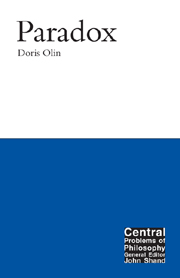Book contents
2 - Paradox and contradiction
Summary
Dialetheism
Paradoxes are baffling. Faced with an apparently impeccable argument that leads to an apparently outrageous conclusion, we are confused and confounded. On the one hand, the conclusion appears false; on the other hand, it apparently must be true. What appears to be cannot be, we assume. This is the source of our fascination; this is why there is a problem.
Recently, impressive arguments have been advanced that this underlying assumption is mistaken. A statement can be both true and false, it is maintained; further, it can be rational to believe that a given statement and its negation are both true. Contradictions (statements of the form “A 〜 ˜A”) can be true, and can be rationally believed. If this view, known as “dialetheism”, prevails, there are clear consequences for the account of paradox. In Chapter 1, three strategies for dealing with a paradox were distinguished: show that the argument is invalid; show that a premise is false; and explain away the appearance of falsity in the conclusion. But if contradictions can be true, and can be rationally believed, then there is another legitimate response to a paradox: accept everything that appears to be the case, that is, grant that the conclusion of the paradoxical argument is both true and false.
This is an apparently fantastic proposal. Until recently, dialetheism would have been dismissed out of hand as a simple conceptual confusion. Largely because of the work of philosopher Graham Priest, however, it has come to be regarded as at least deserving of serious consideration and response.
- Type
- Chapter
- Information
- Paradox , pp. 21 - 36Publisher: Acumen PublishingPrint publication year: 2002



